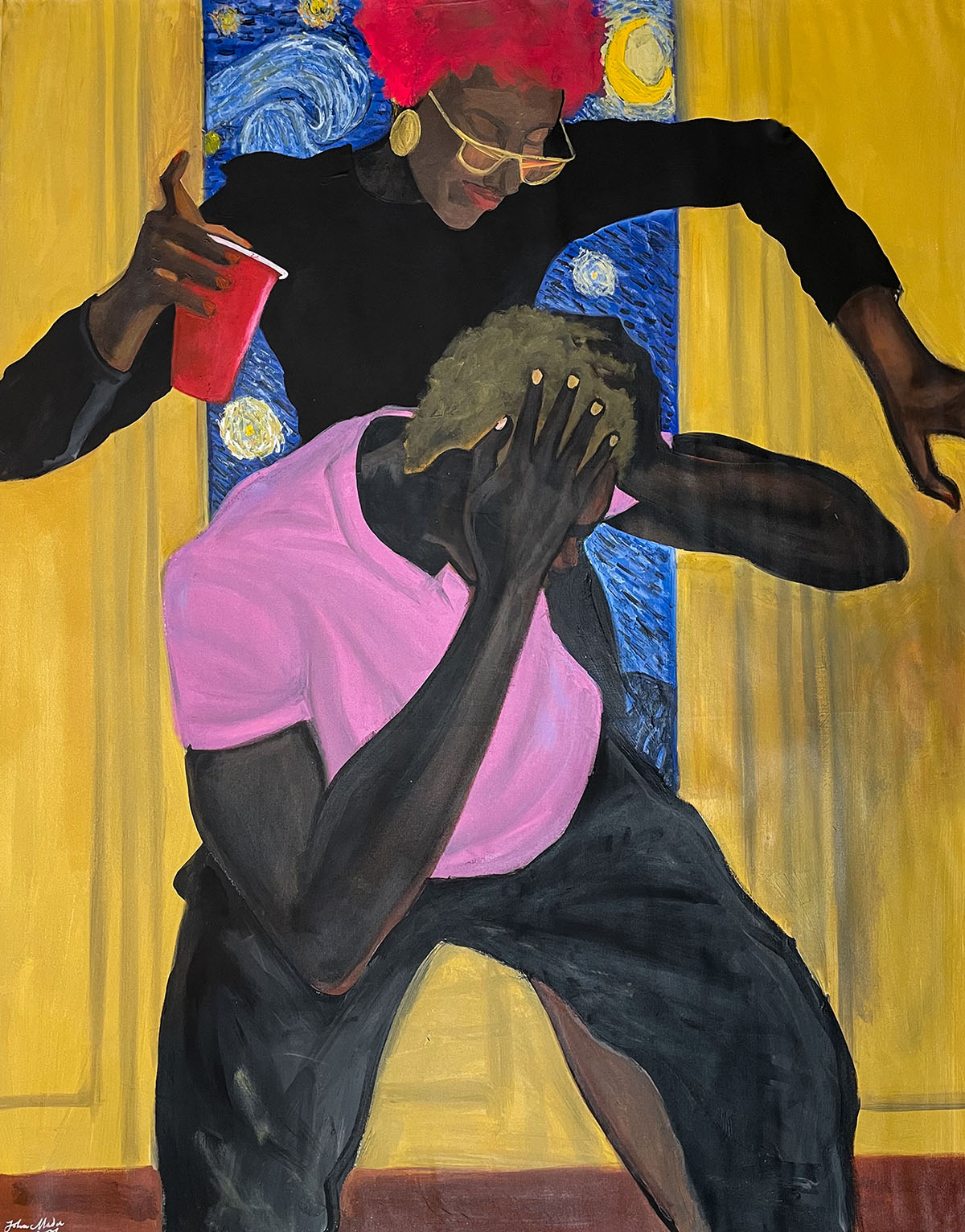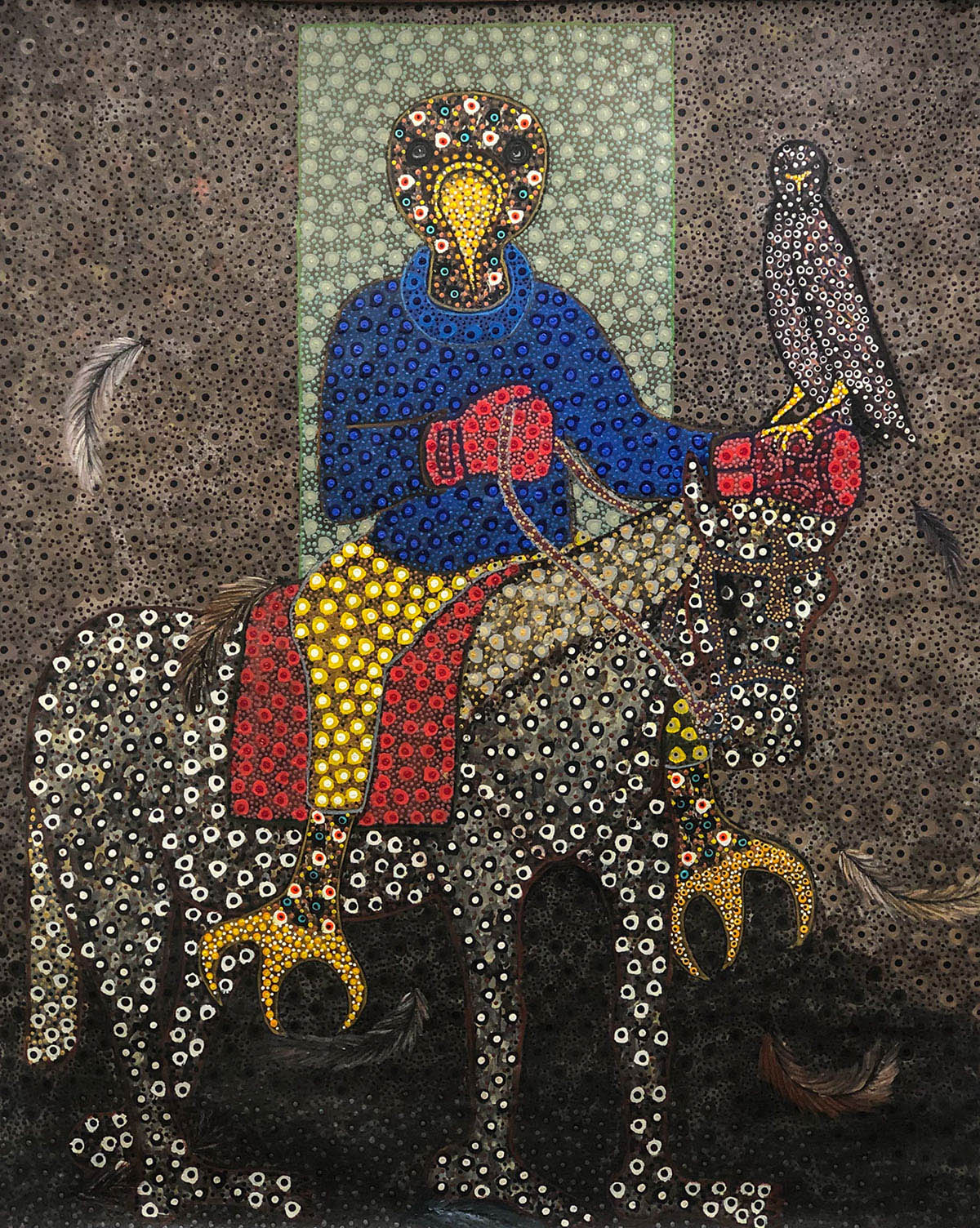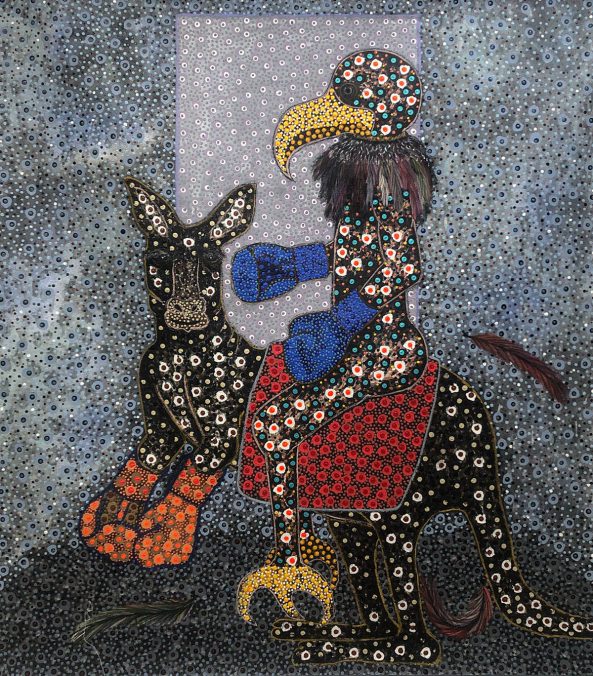
On view from July 10 till August 14, 2021, this new exhibition, the first in France for both artists, brings together over 20 all-new works, addressing notions of power and domination as they unfold through gender and political dynamics. Boldly exposing and bridging each artist’s distinct approach to these topics, AFIKARIS once again demonstrates its commitment to propelling the voices of its artists.

Using their art as a weapon, both artists look back and reappropriate histories governed by the duality between dominant and dominated. Turning to gender dynamics, John Madu overturns traditional clichés on identity in the context of globalization, while Ousmane Niang revisits predetermined social hierarchies. Cuttingly pointing to rampant societal issues, they move beyond raw observation, instead coloring their work with a call for action. In his paintings, Nigerian artist John Madu frees his characters from preconstructed social norms as he rewrites a world where individuals are empowered, and free to hail their identities. Whether painting acquaintances or reinventing classics, Madu records his own history – the story of a young Nigerian generation, lulled by a globalized, universal culture, and in which individuality and uniformity attract and repulse each other. His visual universe is marked by endless references – countless nods to the history of art as to Nigerian youth and pop culture.

John MADU The Kiss 2021 
John MADU Sunflowers and man 2021
In these everyday scenes, Vincent Van Gogh, Gustav Klimt and Keith Haring permeate the artwork with their characteristic features, hiding behind a door, or on a pair of shorts, mirroring the plurality of identities that constitute the artist’s world. Exalting his own reality, he blurs the borders of feminine and masculine. Playing with the curves and hair of his models, female and male, woman and man, dominant and dominated intersect. The roles are reversed, exposing instead fluid identities that beg to be released. Calling out a traditionally patriarchal Nigerian society and appealing to women’s empowerment, he diverts Klimt’s The Kiss (1908-1909): under his brush, it is the woman who kisses the man. Ultimately, in bringing to bear the limits of gender, Madu bestows his characters with a new form of power. He explains:
My art is infused by strong figures that have marked my personal life, and vision of it. Being faced with the many realities and endless conceptions of identity, I seek to blur the set distinctions, in particular as they apply to gender. By switching or reframing gender roles, I play with their symbolic power, and the symbolism of the power they exert.

As he revisits historical bestiaries, Senegalese artist Ousmane Niang plays with the embodiment of power. Marking the distinction between anthropomorphic, domesticated, and wild animals, his canvases become the stage for a role-playing game of strong and weak: the human dominates as the animal obeys. The paintings turn to fables – exposing and distorting these shared illustrations of agreed hierarchies. Reflecting his ongoing interest in the pictorial treatment of games in art, Niang’s Jeu de Cartes series (2019-2021) trade the traditional royal figures with these fabled animals. Purposefully engaging with their symbolism, he projects onto them a new, personal meaning: free to fly, swim, and walk, Niang’s bird becomes a symbol of freedom, and a figure of power. Distinctly adorning these figures, Niang’s stylized dots, characteristic of his art, seize their full meaning. Consistently doubled, they materialize a duality: just as dominant and dominated cohabit in the paintings, problems and solutions emerge. More than a pictorial choice, his dots express the social conflict at the root of his work. Through this technique, the artist offers avenues for reflection – calling his viewers to move beyond contemplation into action, a subtle and empowering echo to the Senegalese youth uprisings of March 2021. Weighing the symbolism in his work, he states:
Power is a game, and in a game, there is always a dimension of power. In my paintings, I embody the game of power in symbolically charged animal figures, and by doing so, shine a light onto it. Behind each dot, there lies a second dot. In the same way, behind each scene, there lies an alternative scene – and behind each problem, a solution.
Ultimately, by bestowing them with a fierce educational virtue, Madu and Niang’s works grow from affronts to alternatives to the status quo – in turn affirming art as its very own form of power.

Ousmane NIANG Jeu de cartes 2021 
Ousmane NIANG Jeu de cartes 2021
About John Madu. John Madu (b. 1983, Lagos, Nigeria) is a multidisciplinary artist living and working in Lagos. With a degree in Policy and Strategic Studies, John Madu is a self-taught artist. Conceived mainly with acrylic, his figurative and symbolic paintings deal with questions of identity, social behaviors, and the effects of cultural globalization on individualism. Highly versatile, Madu’s work is nurtured by endless influences, ranging from popular culture and art to African histories and personal experiences. Symbolism is a distinct marker of his work, as a recurring iconography of books, apples, and other recognizable items come to fill his canvases and convey their own meaning. John Madu’s work has been presented in numerous international exhibitions, including in Lagos, London, New York, and Shanghai. Figures of Power is his first major exhibition in France.
About Ousmane Niang. Emerging Senegalese visual artist Ousmane Niang (b. 1989, Tamba, Senegal) works and lives in Dakar. A graduate of the National School of Arts in Dakar, he works primarily with acrylic. Calling to his personal bestiaries, his paintings, deeply influenced by pointillism, depict scenes of daily life. Addressing notions of power, the human-animal figures that populate his canvases convey the endurance and fragility of social beings in the face of domination – as it governs freedom, tyranny, sharing, traditions, technologies, and family life. Ousmane Niang’s works have been showcased across numerous Senegalese institutions (Institut Français de Dakar; Galerie Nationale de Dakar; Biennale de Dakar) and at international art fairs including AKAA (Paris) and 1-54 (London; New York). Figures of Power is his first major exhibition in France.
About AFIKARIS Gallery, Paris. Founded in 2018 by Florian Azzopardi, AFIKARIS Gallery started as an online platform and showroom specialized in the work of both emerging and established artists from African and its diaspora, before opening a dedicated Paris-based gallery space in 2021. Engaged in promoting cross cultural and disciplinary exchange, AFIKARIS acts as a platform for artists to engage with the wider public. A mirror onto and space for reflection on the contemporary African art scene, it provides artists with a space to address the topical local and international issues at the heart of their art.
Address and contact:
AFIKARIS Gallery
38 rue Quincampoix
75004 Paris, France
www.afikaris.com





